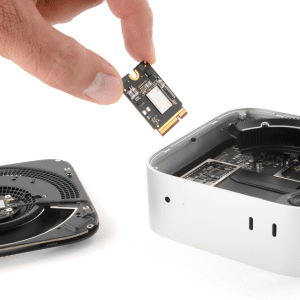The 2025 Mac Studio comes in two flavors: the M4 Max, with up to a 16-core CPU, 40-core GPU, and 128GB of unified memory, and the M3 Ultra, boasting up to a 32-core CPU, 80-core GPU, and a staggering 512GB of unified memory. Benchmarks reveal the M4 Max outperforms its 2023 M2 Ultra predecessor by 26% in multi-core tasks, scoring 26,966 on Geekbench 6, while the M3 Ultra hits 28,376, a 33% leap. For power users, this translates to seamless handling of 8K video editing, real-time 3D rendering, and complex AI model training. The M4 Max’s enhanced Neural Engine and 546GB/s memory bandwidth make it particularly adept for single-core tasks and AI-driven workflows, such as photo editing or generative AI tasks, while the M3 Ultra’s sheer core count excels in multi-core heavy lifting like visual effects or large-scale data processing.
Designed for the Professional Workflow
The Mac Studio’s compact 7.7-by-7.7-inch aluminum chassis belies its robust capabilities. Its thermal design, featuring a large aluminum heatsink for M4 Max models and a copper one for M3 Ultra, ensures near-silent operation even under intense workloads—a boon for audio professionals or those in quiet studio environments. Thunderbolt 5 ports (up to 120Gb/s bandwidth) replace Thunderbolt 4, offering faster data transfer for external drives and peripherals, critical for video editors managing massive files. With two front-facing Thunderbolt 5 ports, an SDXC card reader, and rear ports including four Thunderbolt 5, two USB-A, HDMI, Ethernet, and a 3.5mm audio jack, connectivity is robust. However, the rear power button and audio jack placement can be inconvenient on crowded desks.
Is It Overkill for Most?
For power users, the Mac Studio’s value hinges on workload intensity. Professionals in video production, 3D animation, or AI development will find the M3 Ultra’s multi-core prowess unmatched, especially for tasks like rendering complex scenes or running large language models locally. The M4 Max, starting at $1,999 with 36GB of unified memory and a 512GB SSD, offers a better balance for most creatives, delivering near-comparable performance for single-core tasks and gaming, thanks to M4’s architectural improvements like hardware ray tracing and Dynamic Caching. However, for users whose tasks don’t push hardware limits—say, basic photo editing or casual content creation—the Mac mini with an M4 Pro chip at $1,399 provides ample power at a lower cost. Reviews note that the Mac Studio’s performance often exceeds the needs of average users, making it a niche choice for those who know they need its capabilities.
Cost vs. Value: A Tough Calculation
The Mac Studio’s price is a sticking point. The base M4 Max model at $1,999 is reasonable for its performance, but upgrades quickly escalate costs—a 16-core M4 Max with 64GB of memory and a 1TB SSD hits $2,899, while a maxed-out M3 Ultra reaches $14,099. Since RAM and storage are non-upgradable, power users must commit to higher specs upfront, inflating the initial investment. Compared to the Mac Pro ($6,999 with an older M2 Ultra), the Mac Studio offers superior performance in a smaller package, but it lacks the Mac Pro’s modular expandability. For budget-conscious professionals, refurbished M1 or M2 Max models, often discounted to around $1,500, remain viable, as their performance still handles 4K video editing with ease. Apple’s trade-in program and AppleCare+ add value, but the high cost of top configurations demands careful consideration of workflow needs.
Future-Proofing and Ecosystem Integration
Running macOS Sequoia, the Mac Studio integrates seamlessly with Apple’s ecosystem, supporting features like iPhone Mirroring and Apple Intelligence for enhanced productivity. The M3 Ultra’s Low Power Mode reduces fan noise and energy consumption, ideal for continuous operation, though it lacks the High Power Mode found in MacBook Pro and Mac mini for sustained graphics tasks. With Thunderbolt 5 and Wi-Fi 6E, the Mac Studio is well-equipped for 2025’s connectivity demands, but its non-upgradable nature means users must anticipate future needs. For those eyeing Apple’s rumored M4 Ultra or a refreshed Mac Pro in 2026, waiting might be prudent if current hardware suffices. Yet, for professionals hitting performance bottlenecks now, the Mac Studio’s speed and compact design make it a compelling choice.
Who Should Buy It?
The 2025 Mac Studio shines for power users whose workflows demand uncompromising performance—think visual effects artists, data scientists, or audio engineers working with 96kHz or Atmos mixes. The M4 Max model, particularly with 64GB of memory, strikes a sweet spot for most professionals, offering robust performance without the M3 Ultra’s steep price. If your current Mac, like an M1 or M2 Studio, still handles your tasks, the upgrade may not justify the cost unless you’re pushing the limits of multi-core performance or need Thunderbolt 5. For those with less demanding needs, the Mac mini or a MacBook Pro docked to a display offers better value. Ultimately, the Mac Studio is a premium tool for those who know exactly how they’ll harness its power.















